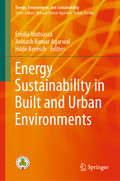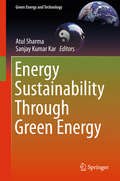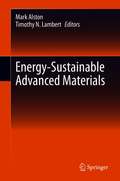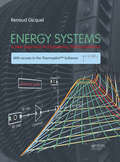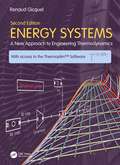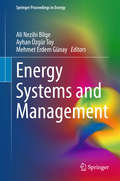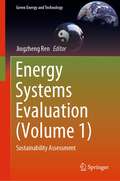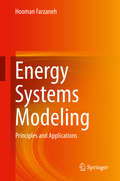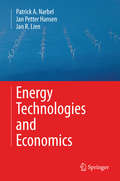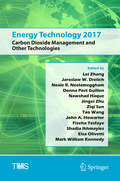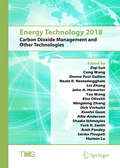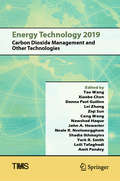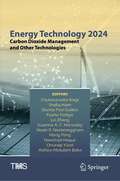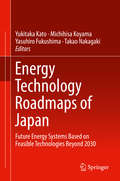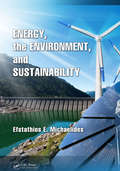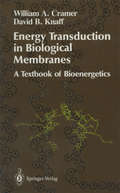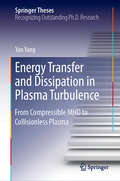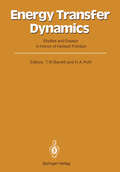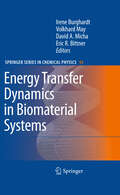- Table View
- List View
Energy, Sustainability and Resilience: A Futuristic Vision from Asia (Disaster Risk Reduction)
by Rajib Shaw Kampanart Silva Nuwong ChollacoopThis book analyzes the experiences of energy, sustainability and resilience issues from different Asian countries and puts forward a futuristic vision of an energy sector for sustained development. Energy is at the core of development, but in energy generation, there are severe environmental implications in many cases. This clearly affects development and causes significant challenges to sustainability. Climate change and disasters have an effect on energy infrastructures and also make significant impacts on humans in terms of both shocks and stresses. Therefore, it is extremely important to understand the linkage of energy, sustainability and resilience. Asia is a hotspot of climate change and disasters, suffering from severe damages to the energy infrastructure of the countries there. At the same time, being a core of world development trajectories, Asia produces and consumes more energy in different sectors than any other part of the world. Also, however, Asia serves as a core region of innovative ideas in energy and related sectors.
Energy Sustainability in Built and Urban Environments (Energy, Environment, and Sustainability)
by Avinash Kumar Agarwal Emilia Motoasca Hilde BreeschThis book covers different aspects of energy sustainability in residential buildings and neighborhoods, starting from the construction and design aspects, and moving on to HVAC systems and lighting, and the applications, harvesting, use and storage of renewable energy. The volume focuses on smart and sustainable use of energy, discussing both the technological advancements and the economic, social and environmental impacts. Novel approaches to recycling of waste and materials in the context of residential buildings are also presented. This volume will be of interest to researchers and policy makers working in the fields of renewable energy, sustainable design and city planning.
Energy Sustainability Through Green Energy (Green Energy and Technology)
by Atul Sharma Sanjay Kumar KarThis book shares the latest developments and advances in materials and processes involved in the energy generation, transmission, distribution and storage. Chapters are written by researchers in the energy and materials field.Topics include, but are not limited to, energy from biomass, bio-gas and bio-fuels; solar, wind, geothermal, hydro power, wave energy; energy-transmission, distribution and storage; energy-efficient lighting buildings; energy sustainability; hydrogen and fuel cells; energy policy for new and renewable energy technologies and education for sustainable energy development.
Energy-Sustainable Advanced Materials
by Mark Alston Timothy N. LambertThis book highlights progress towards the capture, storage, and utilization of energy through the development of advanced materials and systems based on abundant elements, materials, and commodities. Energy is critical to human sustainability and a global-scale deployment of renewable energy systems will be required. Hence, the chapters integrate the fundamental aspects that enable the technical advancements in detail, along with an emphasis on the need for highly sustainable materials to enable real impact for humankind: To determine innovation of energy capture and storage through characterizations of materials in areas of electrical generation and electrical storage systems; To demonstrate better performance, economic and environmental advantages than the current state of the art; To define new chemistries and materials for innovations in energy density design through lower operational temperatures, improve safety, expanding operational voltage, battery durability lifetimes, and reduce system costs. Advances critical technical and commercial objectives for novel high energy density materials;Evaluates operational material models for optimizing energy capture that are integrated by configurations as a system; Illustrates utilization of material life cycle assessment for high energy outputs generators for sustainable materials.
Energy Systems: A New Approach to Engineering Thermodynamics
by Renaud GicquelConsidered as particularly difficult by generations of students and engineers, thermodynamics applied to energy systems can now be taught with an original instruction method. Energy Systems applies a completely different approach to the calculation, application and theory of multiple energy conversion technologies. It aims to create the reader's fo
Energy Systems: A New Approach to Engineering Thermodynamics
by Renaud GicquelConsidered as particularly difficult by generations of students and engineers, thermodynamics applied to energy systems can now be taught with an original instruction method. Energy Systems applies a completely different approach to the calculation, application and theory of multiple energy conversion technologies. It aims to create the reader’s foundation for understanding and applying the design principles to all kinds of energy cycles, including renewable energy. Proven to be simpler and more reflective than existing methods, it deals with energy system modeling, instead of the thermodynamic foundations, as the primary objective. Although its style is drastically different from other textbooks, no concession is made to coverage: with encouraging pace, the complete range from basic thermodynamics to the most advanced energy systems is addressed. The accompanying Thermoptim™ portal (http://thermoptim.org) presents the software and manuals (in English and French) to solve over 200 examples, and programming and design tools for exercises of all levels of complexity. The portal explains to the user how to build appropriate models to bridge the technological reality with the theoretical basis of energy engineering. Offering quick overviews through e-learning modules moreover, the portal is user-friendly and enables users to quickly improve their proficiency. Students can freely download the Thermoptim modeling software demo version (available in seven languages), and extended options are available to lecturers. A professional edition is also available and has been adopted by many companies and research institutes worldwide (www.s4e2.com). This volume is intended as a textbook for courses in applied thermodynamics, energy systems, energy conversion and thermal engineering taken by senior undergraduate and graduate-level students in mechanical, energy, chemical and petroleum engineering. Students should already have taken a first-year course in thermodynamics. The refreshing approach and exceptionally rich coverage make it a great reference tool for researchers and professionals as well.
Energy Systems: A New Approach to Engineering Thermodynamics
by Renaud GicquelConsidered as particularly difficult by generations of students and engineers, thermodynamics applied to energy systems can now be taught with an original instruction method. Energy Systems applies a completely different approach to the calculation, application and theory of multiple energy conversion technologies. It aims to create the reader’s foundation for understanding and applying the design principles to all kinds of energy cycles, including renewable energy. Proven to be simpler and more reflective than existing methods, it deals with energy system modeling, instead of the thermodynamic foundations, as the primary objective. Although its style is drastically different from other textbooks, no concession is made to coverage: with encouraging pace, the complete range from basic thermodynamics to the most advanced energy systems is addressed. The accompanying Thermoptim™ portal (http://thermoptim.org) presents the software and manuals (in English and French) to solve over 200 examples, and programming and design tools for exercises of all levels of complexity. The portal explains to the user how to build appropriate models to bridge the technological reality with the theoretical basis of energy engineering. Offering quick overviews through e-learning modules moreover, the portal is user-friendly and enables users to quickly improve their proficiency. Students can freely download the Thermoptim modeling software demo version (available in seven languages), and extended options are available to lecturers. A professional edition is also available and has been adopted by many companies and research institutes worldwide (www.s4e2.com). This volume is intended as a textbook for courses in applied thermodynamics, energy systems, energy conversion and thermal engineering taken by senior undergraduate and graduate-level students in mechanical, energy, chemical and petroleum engineering. Students should already have taken a first-year course in thermodynamics. The refreshing approach and exceptionally rich coverage make it a great reference tool for researchers and professionals as well.
Energy Systems and Management (Springer Proceedings in Energy)
by Ali Nezihi Bilge Ayhan Özgür Toy Mehmet Erdem GünayReaders of this work will find examinations of the current status and future status for energy sources and technologies, their environmental interactions and the relevant global energy policies. The work begins with an overview of Energy Technologies for a Sustainable Future, which examines the correlation between population, economy and energy consumption in the past, and reviews the conventional and renewable energy sources as well as the management of them to sustain the ever-growing energy demand in the future. The rest of the chapters are divided into 3 parts; the first part of the book, “Energy Sources, Technologies and Environment”, consists of 12 chapters, which include research on new energy technologies and evaluation of their environmental effects. The second part “Advanced Energy Materials” includes 7 chapters devoted to research on material science for new energy technologies. The final section titled “Energy Management, Economics and Policy” is comprised of 10 chapters about planning, controlling and monitoring energy related processes together with the policies to satisfy the needs of increasing population and growing economy. The chapters are selected works from the International Conference on Energy and Management, which was organized by Istanbul Bilgi University Department of Energy Systems Engineering and PALMET Energy to share the knowledge on the recent trends, scientific developments, innovations and management methods in energy, and held on 5–7th June 2014 at Istanbul Bilgi University.
Energy Systems Evaluation: Sustainability Assessment (Green Energy and Technology)
by Jingzheng RenThis book presents various methods for sustainability assessment of energy systems, under various different conditions and scenarios. It answers the questions of how to measure the sustainability of energy systems by adopting appropriate metrics and methods. This book provides readers with a comprehensive view of the frontiers of sustainability assessment methods for energy system analysis. It presents various methodologies, allowing readers to understand: the complete metrics for sustainability assessment; life cycle thinking for sustainability assessment of energy systems; and the advanced sustainability assessment methods for energy systems. This book is of interest to researchers, engineers, decision makers, and postgraduate students within the field of energy systems, sustainability, and decision analysis.
Energy Systems Modeling: Principles and Applications
by Hooman FarzanehThis book serves as an introductory reference guide for those studying the application of models in energy systems. The book opens with a taxonomy of energy models and treatment of descriptive and analytical models, providing the reader with a foundation of the basic principles underlying the energy models and positioning these principles in the context of energy system studies. In turn, the book provides valuable insights into the varied applications of different energy models to answer complex questions, including those concerning specific aspects of energy policy measures dealing with issues of supply and demand. Case studies are provided in all of the chapters, offering real-world examples of how existing models fit the classification methods outlined here. The book’s remaining chapters address a broad range of principles and applications, taking the reader from the basic principles involved, to state-of-the-art energy production and consumption processes, using modeling and validation/illustration in case studies to do so. With its in-depth mathematical foundation, this book serves as a comprehensive collection of work on modeling energy systems and processes, taking inexperienced graduate students from the basics through to a high-level understanding of the modeling processes in question, while also providing professionals and academic researchers in the field of energy planning with an up-to-date reference guide covering the latest works.
Energy Technologies and Economics
by Patrick A. Narbel Jan Petter Hansen Jan R. LienThis is an easy-to-read textbook providing the reader with the basis to comprehend the major energy technologies from a physical and economical perspective.The journey through the book begins with some background theory on the physics and economics of energy. Major energy technologies (fossil, nuclear and renewable) are explored in-depth, explaining how they work and the costs involved. Finally, the journey ends by exploring the technical and economic feasibility of supplying the world by 2050 with sustainable energy only.Numerous examples are provided to allow the reader to relate important concepts to real-life. The reader’s understanding of the material can then be tested using the exercises at the end of each chapter.This textbook is the first to thoroughly present the physics and the economics of energy. It is intended for graduate students and practitioners interested in the field of energy. It also enables the general reader to distinguish between political statement and fact.
Energy Technology 2017: Carbon Dioxide Management and Other Technologies (The Minerals, Metals & Materials Series)
by Lei Zhang Jaroslaw W. Drelich Neale R. Neelameggham Donna Post Guillen Nawshad Haque Jingxi Zhu Ziqi Sun Tao Wang John A Howarter Fiseha Tesfaye Shadia Ikhmayies Elsa Olivetti Mark William KennedyThis collection focuses on energy efficient technologies including innovative ore beneficiation, smelting technologies, recycling and waste heat recovery. The volume also covers various technological aspects of sustainable energy ecosystems, processes that improve energy efficiency, reduce thermal emissions, and reduce carbon dioxide and other greenhouse emissions. Papers addressing renewable energy resources for metals and materials production, waste heat recovery and other industrial energy efficient technologies, new concepts or devices for energy generation and conversion, energy efficiency improvement in process engineering, sustainability and life cycle assessment of energy systems, as well as the thermodynamics and modeling for sustainable metallurgical processes are included. This volume also offers topics on CO2 sequestration and reduction in greenhouse gas emissions from process engineering, sustainable technologies in extractive metallurgy, as well as the materials processing and manufacturing industries with reduced energy consumption and CO2 emission. Contributions from all areas of non-nuclear and non-traditional energy sources, such as solar, wind, and biomass are also included in this volume.Papers from the following symposia are presented in the book:Energy TechnologiesAdvances in Environmental Technologies: Recycling and Sustainability Joint SessionDeriving Value from Challenging Waste Materials: Recycling and Sustainability Joint SessionSolar Cell Silicon
Energy Technology 2018: Carbon Dioxide Management and Other Technologies (The Minerals, Metals & Materials Series)
by Ziqi Sun Cong Wang Donna Post Guillen Neale R Neelameggham Lei Zhang John A. Howarter Tao Wang Elsa Olivetti Mingming Zhang Dirk Verhulst Xiaofei Guan Allie Anderson Shadia Ikhmayies York R. Smith Amit Pandey Sarma Pisupati Huimin LuThis collection focuses on energy efficient technologies including innovative ore beneficiation, smelting technologies, recycling and waste heat recovery. The volume also covers various technological aspects of sustainable energy ecosystems, processes that improve energy efficiency, reduce thermal emissions, and reduce carbon dioxide and other greenhouse emissions. Papers addressing renewable energy resources for metals and materials production, waste heat recovery and other industrial energy efficient technologies, new concepts or devices for energy generation and conversion, energy efficiency improvement in process engineering, sustainability and life cycle assessment of energy systems, as well as the thermodynamics and modeling for sustainable metallurgical processes are included. This volume also includes topics on CO2 sequestration and reduction in greenhouse gas emissions from process engineering, sustainable technologies in extractive metallurgy, as well as the materials processing and manufacturing industries with reduced energy consumption and CO2 emission. Contributions from all areas of non-nuclear and non-traditional energy sources, such as solar, wind, and biomass are also included in this volume.Papers from the following symposia are presented in the book:Energy Technologies and CO2 ManagementAdvanced Materials for Energy Conversion and Storage Deriving Value from Challenging Waste Streams: Recycling and Sustainability Joint SessionSolar Cell SiliconStored Renewable Energy in Coal
Energy Technology 2019: Carbon Dioxide Management and Other Technologies (The Minerals, Metals & Materials Series)
by Tao Wang Xiaobo Chen Donna Post Guillen Lei Zhang Ziqi Sun Cong Wang Nawshad Haque John A. Howarter Neale R Neelameggham Shadia Ikhmayies York R. Smith Leili Tafaghodi Amit PandeyThis collection addresses the need for sustainable technologies with reduced energy consumption and pollutants and the development and application of alternative sustainable energy to maintain a green environment and energy supply. Contributions focus on energy-efficient technologies including innovative ore beneficiation, smelting technologies, and recycling and waste heat recovery, as well as emerging novel energy technologies. Papers also cover various technological aspects of sustainable energy ecosystems, processes that improve energy efficiency, reduce thermal emissions, and reduce carbon dioxide and other greenhouse emissions. Papers from the following symposia are presented in the book: Energy Technologies and Carbon Dioxide ManagementSolar Cell Silicon Advanced Materials for Energy Conversion and Storage
Energy Technology 2024: Carbon Dioxide Management and Other Technologies (The Minerals, Metals & Materials Series)
by Chukwunwike Iloeje Shafiq Alam Donna Post Guillen Fiseha Tesfaye Lei Zhang Susanna A. C. Hockaday Neale R. Neelameggham Hong Peng Nawshad Haque Onuralp Yücel Alafara Abdullahi BabaThis collection is focused on industrial energy sustainability and CO2 management, including processes that improve energy efficiency and reduce or eliminate industrial GHG emissions. Topics address technology areas such as clean energy technologies, innovative beneficiation, smelting technologies, process intensification, as well as CO2 capture and conversion for industrial applications. Areas of interest include, but are not limited to: · Decarbonizing Materials Processing · Use of low carbon fuels, feedstock, and renewable energy resources for materials processing. · Emerging processes and techniques for industrial CO2 capture, conversion/upgrade · CO2 and other GHG reduction metallurgy in ferrous, non-ferrous and reactive metals processing, including rare-earth metals. · Energy Efficiency & Industrial Electrification · Electrification of industrial process heat and electrified production of energy carriers (e.g., hydrogen, ammonia) · Energy efficiency improvements for materials processing and smart manufacturing for optimized process control · System integration and thermal integration of process heat, waste heat recovery, and other technologies for industrial energy efficiency · Sustainability Analysis · Techno-economic life-cycle, resource efficiency and circular economy modeling of energy-intensive processes and associated material supply chains · The role of energy education and regulation in energy and materials sustainability
Energy Technology Roadmaps of Japan: Future Energy Systems Based on Feasible Technologies Beyond 2030
by Yukitaka Kato Michihisa Koyama Yasuhiro Fukushima Takao NakagakiThis book, edited by members of the Committee of Future Energy and Social Systems, The Society of Chemical Engineers, Japan, describes energy technology roadmaps for Japan post-Fukushima. In this work, energy technology experts show quantitatively the advantages and disadvantages of major energy technologies with which they are involved, in a unified chapter structure with figures illustrating the technology development perspectives. The future energy vision for Japan together with the pathway is quantitatively discussed, explicitly considering the contributions of individual energy technology by referring to the technology roadmaps. The pathways for future energy vision thus derived will be useful not only for all energy researchers but also for graduate students in the field to grasp the potential of the technologies and future energy system of Japan.
Energy, the Environment, and Sustainability (Mechanical and Aerospace Engineering)
by Efstathios E. MichaelidesEnergy and the Environment explains in simple terms what the energy demand is at the present, what the environmental effects of energy use are, and what can be accomplished to alleviate the environmental effects of energy use and ensure adequate energy supply. Though technical in approach, the text uses simple explanations of engineering processes and systems and algebra-based math to be comprehensible to students in a range of disciplines. Schematic diagrams, quantitative examples, and numerous problems will help students make quantitative calculations. This will assist them in comprehending the complexity of the energy-environment balance, and to analyze and evaluate proposed solutions.
Energy, the Environment, and Sustainability (Mechanical and Aerospace Engineering)
by Efstathios E. MichaelidesEnergy and the Environment explains in simple terms what the energy demand is at the present, what the environmental effects of energy use are, and what can be accomplished to alleviate the environmental effects of energy use and ensure adequate energy supply. Though technical in approach, the text uses simple explanations of engineering processes and systems and algebra-based math to be comprehensible to students in a range of disciplines. Schematic diagrams, quantitative examples, and numerous problems will help students make quantitative calculations. This will assist them in comprehending the complexity of the energy-environment balance, and to analyze and evaluate proposed solutions.
Energy Transduction in Biological Membranes: A Textbook of Bioenergetics (Springer Advanced Texts in Chemistry)
by William A. Cramer David B. KnaffEnergy Transduction in Biological Membranes was primarily designed for graduate courses in bioenergetics. Not only does it discuss basic principles and concepts central to modern membrane biochemistry, biophysics and molecular biology, but also (1) the components and pathways for electron transport and hydrogen ion translocation, and (2) the utilization of electrochemical ion gradients. The book is unique in presenting a comparative treatment of respiratory and photosynthetic energy transduction, and in using protein sequence data coupled with physical concepts to discuss the mechanisms of energy transducing proteins.
Energy Transfer and Dissipation in Plasma Turbulence: From Compressible MHD to Collisionless Plasma (Springer Theses)
by Yan YangThis book revisits the long-standing puzzle of cross-scale energy transfer and dissipation in plasma turbulence and introduces new perspectives based on both magnetohydrodynamic (MHD) and Vlasov models. The classical energy cascade scenario is key in explaining the heating of corona and solar wind. By employing a high-resolution hybrid (compact finite difference & WENO) scheme, the book studies the features of compressible MHD cascade in detail, for example, in order to approximate a real plasma cascade as “Kolmogorov-like” and to understand features that go beyond the usual simplified theories based on incompressible models. When approaching kinetic scales where plasma effects must be considered, it uses an elementary analysis of the Vlasov–Maxwell equations to help identify the channels through which energy transfer must be dissipated. In addition, it shows that the pressure–strain interaction is of great significance in producing internal energy. This analysis, in contrast to many other recent studies, does not make assumptions about wave-modes, instability or other specific mechanisms responsible for the dynamics – the results are direct consequences of the Vlasov–Maxwell system of equations. This is an important step toward understanding dissipation in turbulent collisionless plasma in space and astrophysics.
Energy Transfer Dynamics: Studies and Essays in Honor of Herbert Fröhlich on His Eightieth Birthday
by Terence William Barrett Herbert A. PohlOn three occasions and at different locations, conferences were held to honor the eightieth birthday of Professor Herbert Frohlich: on the 18th December, 1985, in Liverpool, England; on the 14th February, 1986, in Stuttgart, Germany; and on the 8th March, 1986, on the Palm Coast, Florida. This Festschrift is a compilation of the papers of those conferences. Frohlich's choice of problems, from the earliest days, was couched in the phy sics of intrinsically interacting systems of excitation. One example, in which he set the course of research which is still followed, concerned dielectric breakdown, developed from the 1930's over several decades. The interacting systems are the electrons (receiving energy from an electric field) and lattice atom motion (taking energy from the electrons via "electron-phonon" interaction, hence heat dissipa tion). There is a threshold field above which the latter cannot keep up with the former, and the combined system (electrons plus phonons) "runs away"; that is to say, collectively it switches to a new state.
Energy Transfer Dynamics in Biomaterial Systems (Springer Series in Chemical Physics #93)
by Irene Burghardt V. May David A. Micha E. R. BittnerThe role of quantum coherence in promoting the e ciency of the initial stages of photosynthesis is an open and intriguing question. Lee, Cheng, and Fleming, Science 316, 1462 (2007) The understanding and design of functional biomaterials is one of today’s grand challenge areas that has sparked an intense exchange between biology, materials sciences, electronics, and various other disciplines. Many new - velopments are underway in organic photovoltaics, molecular electronics, and biomimetic research involving, e. g. , arti cal light-harvesting systems inspired by photosynthesis, along with a host of other concepts and device applications. In fact, materials scientists may well be advised to take advantage of Nature’s 3. 8 billion year head-start in designing new materials for light-harvesting and electro-optical applications. Since many of these developments reach into the molecular domain, the - derstanding of nano-structured functional materials equally necessitates f- damental aspects of molecular physics, chemistry, and biology. The elementary energy and charge transfer processes bear much similarity to the molecular phenomena that have been revealed in unprecedented detail by ultrafast op- cal spectroscopies. Indeed, these spectroscopies, which were initially developed and applied for the study of small molecular species, have already evolved into an invaluable tool to monitor ultrafast dynamics in complex biological and materials systems. The molecular-level phenomena in question are often of intrinsically quantum mechanical character, and involve tunneling, non-Born- Oppenheimer e ects, and quantum-mechanical phase coherence.
Energy transfer in a circuit (large print)
by RnibOn this page is an electrical circuit diagram with a battery, a variable resistor, a filament bulb and a voltmeter. There is a locator dot shown, which will be at the top left of the page when the image is the correct way up. The battery is at the top centre of the image and going anti-clockwise from it are the variable resistor and the filament bulb and voltmeter in parallel.
Energy transfer in a circuit (UEB contracted)
by RnibOn this page is an electrical circuit diagram with a battery, a variable resistor, a filament bulb and a voltmeter. There is a locator dot shown, which will be at the top left of the page when the image is the correct way up. The battery is at the top centre of the image and going anti-clockwise from it are the variable resistor and the filament bulb and voltmeter in parallel.
Energy transfer in a circuit (UEB uncontracted)
by RnibOn this page is an electrical circuit diagram with a battery, a variable resistor, a filament bulb and a voltmeter. There is a locator dot shown, which will be at the top left of the page when the image is the correct way up. The battery is at the top centre of the image and going anti-clockwise from it are the variable resistor and the filament bulb and voltmeter in parallel.

